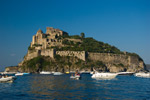 The island of Ischia has an ancient origin. The first evidence of residential areas on the island can be found in the Lacco Ameno, where around half of the eighth century BC, a Greek colony was to put their roots. The characteristics of the sites responded to the logic and the requirements of a human settlement.
The island of Ischia has an ancient origin. The first evidence of residential areas on the island can be found in the Lacco Ameno, where around half of the eighth century BC, a Greek colony was to put their roots. The characteristics of the sites responded to the logic and the requirements of a human settlement.The promontory of Monte Vico, by the three sides overlooking the sea, became the acropolis, the two bays "under Varuli" and "San Montano" functioned respectively from the commercial port and shelter to vessels in case of an attack from the mainland; the plain of Santa Restituta allowed the productive activity of the small town, located also in Arbusto, Mezzavia and Mazzola and finally the valley of San Montano hosted the necropolis. It had to be a colony of a certain size, judging by the wealth of finds. At Monte Vico there are traces of Greek walls, basement blocks of temple and the remains of walls and dry kilns, ceramics, metals, various fragments, indicating intense commercial activity.
Phitecusa was certainly founded by the Greeks and specifically the Eubei, but it was also frequented by different populations, as demonstrated by the many materials found, which are not only of Greek workmanship. According to many scholars, the citadel of Phitecusa was a sort of free port used to trade from eastern markets, by artisans from Syria, Egypt, Puglia, Calabria.
From the origins to the first century BC.
From Romans to the Middle Ages
From the Renaissance to the eighteenth century
From the nineteenth century to the present day







